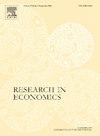人工智能:重新定义退休模式
IF 1.2
Q3 ECONOMICS
引用次数: 0
摘要
建立了一个内生的经济增长模型,其中在工作场所使用人工智能(ai)和延长工作寿命的决定是内生的和相互依存的。工人之间的异质性有四个来源:初始生产率的差异、老龄化过程的差异、人工智能投资对就业机会的限制,以及人工智能对有机会就业的人的影响不均衡。研究表明,那些在工作中不使用人工智能的人保持着传统的退休模式,其中受教育程度最高和/或最健康的人延长了他们的工作寿命。相比之下,使用人工智能的工人的退休模式发生了变化,从人工智能中获益最多的是用户,他们将延长自己的工作寿命。这是因为人工智能弥补了随着年龄增长而退化的技能,从而使劳动力市场更具持久性。本文章由计算机程序翻译,如有差异,请以英文原文为准。
Artificial intelligence: Redefining the retirement pattern
An endogenous economic growth model is developed, where the decisions to use artificial intelligences (AIs) in the workplace and to extend working life are endogenous and interdependent. There are four sources of heterogeneity among workers: differences in initial productivity, variations in the aging process, restricted access to jobs with AI investment, and uneven impact of AIs among those who have access. It is shown that those who do not use AIs in their jobs maintain a traditional pattern of retirement, with the most educated and/or healthy among them extending their working lives. In contrast, the retirement pattern for AI-using workers changes, and it is the users who derive the most benefit from AIs who will extend their working lives. This is because AIs compensate for the skills that tend to deteriorate with age, thus allowing for greater permanence in the labour market.
求助全文
通过发布文献求助,成功后即可免费获取论文全文。
去求助
来源期刊

Research in Economics
ECONOMICS-
CiteScore
1.40
自引率
0.00%
发文量
37
审稿时长
89 days
期刊介绍:
Established in 1947, Research in Economics is one of the oldest general-interest economics journals in the world and the main one among those based in Italy. The purpose of the journal is to select original theoretical and empirical articles that will have high impact on the debate in the social sciences; since 1947, it has published important research contributions on a wide range of topics. A summary of our editorial policy is this: the editors make a preliminary assessment of whether the results of a paper, if correct, are worth publishing. If so one of the associate editors reviews the paper: from the reviewer we expect to learn if the paper is understandable and coherent and - within reasonable bounds - the results are correct. We believe that long lags in publication and multiple demands for revision simply slow scientific progress. Our goal is to provide you a definitive answer within one month of submission. We give the editors one week to judge the overall contribution and if acceptable send your paper to an associate editor. We expect the associate editor to provide a more detailed evaluation within three weeks so that the editors can make a final decision before the month expires. In the (rare) case of a revision we allow four months and in the case of conditional acceptance we allow two months to submit the final version. In both cases we expect a cover letter explaining how you met the requirements. For conditional acceptance the editors will verify that the requirements were met. In the case of revision the original associate editor will do so. If the revision cannot be at least conditionally accepted it is rejected: there is no second revision.
 求助内容:
求助内容: 应助结果提醒方式:
应助结果提醒方式:


